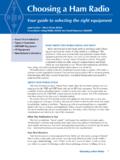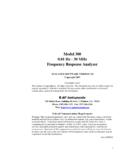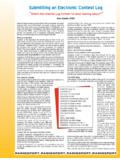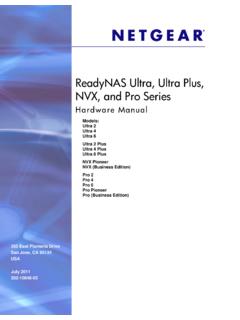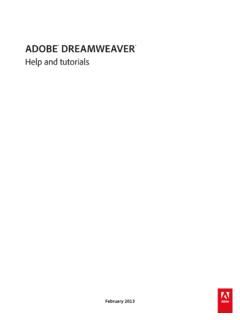Transcription of User manual - Specair
1 User manual Version Copyright 2012 SpectralFit, Table of contents Table of contents .. 1. Specair in 3 minutes .. 3. 1. Introduction to Specair .. 6. 2. The Specair User Interface .. 7. Menu Bar .. 8. Toolbar .. 18. Plot Area .. 19. Comments Area .. 20. Calculated Spectra .. 21. Options for Calculated Spectra .. 21. Calculation Options .. 23. 3. The Slit Function .. 26. Trapezoidal Slit 26. Imported Slit Function .. 26. 4. Spectral fitting .. 28. Basic fitting .. 28. Finding transitions .. 30. Global fit .. 32. 5. The physical model for radiation used in Specair .. 34. Energy 34. Spin .. 34. Selection rules .. 35. Example .. 35. Emission intensity .. 36. Copyright 2012 SpectralFit, 2 Rev. Specair in 3 minutes Specair is a program for calculating emission or absorption spectra of air plasma radiation. It can calculate, display and save spectra based on a wide range of user input parameters. The main user interface sections of Specair are indicated in Figure 1 below. To create a new spectrum the user specifies the input parameters for a new spectrum in the Calculation Options area to the left, and presses the Calculate spectrum button in the top left corner.
2 The new spectrum will be displayed automatically in the Plot area in the center. Comments to individual spectra can be added in the Comments Area at the bottom, and the appearance of the spectrum can be changed in the Calculated Spectra area to the right or under the Plot menu. By selecting a spectrum at the top of this area, the user can see the used Calculation Options in the area to the bottom right. In addition to calculating spectra, Specair can import experimental spectra in most of the commonly used file formats. Using Specair , the user can manipulate both imported and calculated spectra, by selecting the spectrum in the Calculated Spectra area and choosing among the options in the Data menu. The data can be exported to other applications either by choosing Export spectrum in the File menu, or by selecting Display Data in the Data menu and the use Copy and Paste to, for example, MS Excel. An actual plasma emission spectrum consists of many sharp lines, each broadened by several mechanisms including Doppler, collisional, natural or Stark broadening.
3 In reality, however, the resolution of the collected data is determined by the instrumental broadening specific to each experimental setup. In Specair instrumental broadening is taken into account by convolving the plasma emission spectrum with a Slit function'. The slit function represents the broadening caused by the spectrometer (slit width, pixel width, grating dispersion) and can be changed by selecting Slit Function from the Tools menu. The user can either use a trapezoidal slit function or import an experimental file. The imported file should be in a commonly used file format. Specair has about 60 input parameters, all set in the Calculation options, which together determine the wavelength and intensity for each peak in the spectrum. The peaks, which correspond to various transitions between the internal energy states of atoms or molecules, are determined by the population of plasma species in the various energy levels, the energy differences and transitions rules between the excited states, and the radiative transition probabilities.
4 1. Temperatures The electronic, rotational, translational and vibrational temperatures, in Kelvin, define the respective Boltzmann population distributions of the internal energy levels. 2. Pressure The pressure can be set using several different units, and determine radiation intensity and the level of absorption. 3. Wavelength Range (nm). This specifies the wavelength range over which the spectrum will be computed. Copyright 2012 SpectralFit, 3 Rev. 4. Calculation Settings The calculation settings allows the user to change certain aspects of the calculations, such as whether to include absorption, to generate Mole fractions automatically, or to convolve the spectrum with a slit function, to replicate experimental conditions. The Speed display option is recommended as it reduces lowers the resolution to match that of the slit function. 5. Mole Fractions The relative amount of each species is indicated here. For plasma consisting of only one species the value should be 1, otherwise use fractional values.
5 For example, use for N2 and for CO, for two equal concentrations of these species. If the sum of the mole fractions of the species defined in your calculations exceeds unity, the program will still compute the spectrum, but a warning message will be given. 6. Radiative Transitions Specair includes most of the common transitions for air plasmas, but also for plasmas containing carbon species. The naming of the transitions conforms to the standard spectroscopy conventions. The spectroscopic transitions to model are selected by entering a 1'. To exclude the transition, set the value to 0'. The numerical value is used as a multiplier to the Einstein emission coefficients and to the population in the upper state of the transition. Although calculations should normally be performed with these parameters set to one, any other numerical value can also be used. For example, choosing a value of 2 is a convenient way to multiply the population of the emitting level by a factor of 2. This could be useful to determine the extent of nonequilibrium in the population of excited states.
6 7. Room air absorbers to consider This section lets the user specify experimental conditions, compensating for absorption in the air between the plasma and the spectrometer. Note that the absorbing species are considered to be at room temperature for this option. Set species to On to include them in the calculations, and specify the path length of air, in cm, and the relative mole fractions ( for 21% oxygen in air etc.). Copyright 2012 SpectralFit, 4 Rev. Calculated Spectra Calculation Options Options for Calculated Spectra Plot Area Comments Area Figure 1. Screen shot of Specair . Copyright 2012 SpectralFit, 5 Rev. 1. Introduction to Specair Specair is a computer program that models radiative spectra for plasmas. The areas of applications include analysis of plasma spectra and heat flux calculations, and it has been verified by numerous experiments. The calculations in Specair are based on a quantum mechanical model that describes each energy level of the species included. The species are the most important radiating atoms, ions and diatomic molecules present in air plasmas, N2, O2, NO, N2+, N, O, C, The spectra of diatomic molecules are computed as described in.
7 Laux, , Optical Diagnostics and Collisional-Radiative Models, VKI Course on Hypersonic Entry and Cruise Vehicles, Stanford University, June 30 July 3, 2008. The latest iteration of Specair combines a fast engine for calculations with an intuitive and versatile Windows-based user interface. The engine is written in Fortran, for maximal performance, and can calculate a high-resolution spectrum within a few seconds on a modern desktop computer. While spectra can be exported for advanced analysis or presentation purposes, the Specair interface provides many basic functions for immediate analysis. Copyright 2012 SpectralFit, 6 Rev. 2. The Specair User Interface The Specair user interface, see Figure 2, offers many functions, which are detailed in the subsequent sections. After specifying the Calculation options for a spectrum, the user starts the calculation by pressing the Calculate spectrum button, by selecting Spectrum > Calculate Spectrum from the menu bar, or by pressing the F2 button.
8 Once calculated, the spectrum will be displayed and ready to work with, using the functionalities described below. 2. Toolbar 5. Calculated Spectra 1. Menu Bar 7. Calculation Options 6. Options for Calculated Spectra 3. Plot Area 4. Comments Area Figure 2. The Specair user interface. Copyright 2012 SpectralFit, 7 Rev. Menu Bar File menu New Ctrl+N. Create a new Specair project. This clears all the calculated spectra. The program will ask you if you want to save the current project, before closing it. Open Ctrl+O. Open an existing Specair project. A Specair project contains all calculated spectra and the options used to calculate them, as well as any imported files. Save Ctrl+S. Save the current project to a Specair data file. Save As Save the project as a new Specair data file. Import spectrum . Import a data file containing a spectrum. Most commonly use file formats are supported, such as Galactic .spc and JCamp-DX .jdx. For a text file the data should be listed in two columns, wavelength in nm and intensity, separated by spaces or tabs.
9 Export spectrum . Export the spectrum selected in the Calculated Spectra area. For an ASCII text file output the file will contain two columns, wavelength in nm and intensity, separated by tabs. Specair also supports other commonly used file formats used in other applications. Save as image . Save the current view in the Graph Area to an image file. Several of the most popular image file formats are available (Bitmap, JPG, EMF, PNG, GIF, TIFF). Print graph Ctrl+P. Open a print dialog box for printing of the current view in the Graph Area. Exit Exit Specair . Copyright 2012 SpectralFit, 8 Rev. Edit menu Cut Ctrl+X. Cut the current field. Works with most text fields. Copy Ctrl+C. Copy the current field. Works with most text fields. Paste Ctrl+V. Paste the clipboard content to a field. Copy Image to Clipboard Copy the current view in the Plot Area to the Clipboard. The image can be pasted into other programs, such as MS Office. View menu Options Ctrl+Alt+O. Show the Calculation Options.
10 Spectra Ctrl+Alt+G. Show the Calculated Spectra. Comments Ctrl+Alt+C. Show the Comments. Copyright 2012 SpectralFit, 9 Rev. Data menu The data menu provides a number of operations that can be performed on both imported and calculated spectra. These functions are useful for correcting experimental spectra for drift, imperfect calibrations or different scaling. They also give the user a way to compare spectra, integrate them and to access the numerical data for further processing. Normalize Normalize all the selected spectra to a maximum value of 1. Normalize at Wavelength Open a dialog box for normalizing selected spectra at a given wavelength. The wavelength is initially set by the vertical marker but can be changed by the user. All spectra will be divided by the value the specified wavelength, determined by interpolation if necessary. Find Minimum Find the minimum value among the data in the selected spectra. The cursor is placed at that point and the coordinates are displayed in the top right corner until the mouse enters the plot area.
